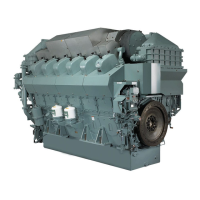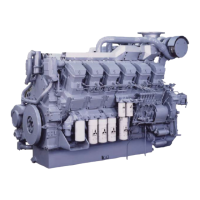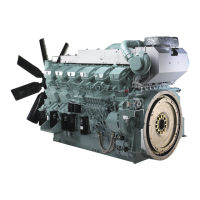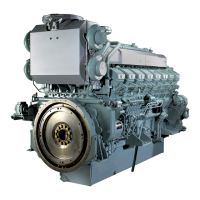14 APPENDIX
Mitsubishi Diesel Engine S12R OPERATION & MAINTENANCE MANUAL
201
Pub. No. 291Y1-40720 Revision: 5
Service Limit for Engine Oil
Properties
■ Kinetic Viscosity
Kinetic viscosity is a basic physical property of
engine oil and is considered as the most important
factor when evaluating oil.
The kinetic viscosity decreases by contamination
with blow-by gas and increases by degradation of
oil. Due to increased viscosity, sludge produced in
the process accumulates in engine and may cause
lubrication oil filter clogging.
Also, the viscosity decreases by contamination with
fuel or engine oil and molecular disconnection of
the viscosity index improver.
The decreased viscosity causes insufficient
lubrication that will cause friction or wear of engine
parts.
■ Base Number
Base number shows the ability to neutralize acids
such as organic acid due to engine oil oxidation,
and sulfurous or sulfuric acid due to the combustion
of sulfur content in fuel.
Because the base number indicates the amount of
dispersant detergent in oil, it can be used to
estimate the consumption of basic dispersant
detergent. The ability to disperse sludge declines
as the dispersant detergent is consumed. Thus, the
base number is often used as an indication of
cleaning capability decline.
■ Acid Number
The acid number in oil increases as the organic
acid is being derived by the engine oil oxidation, or
sulfurous acid or sulfuric acid derived by the
combustion of sulfur content of fuel, or the oil
becomes contaminated with imperfect combustion
products. An increase in the acid number will result
in corrosion or wear of the inner parts of the engine
(such as cylinder liner and bearing) due to sulfur
content, and the piston ring seizure due to sludge.
■ Water Content
Water in oil promotes corrosion/wear, and
decreases lubricity in sliding parts.
■ Flash Point
The flash point is lowered by contamination with
fuel. Flash point is used to check the fuel dilution of
oil. The dilution of oil reduces oil film, and causes
insufficient lubrication that will cause friction or
wear of engine parts.
■ Insolubles
Insolubles include acid products of engine oil,
imperfect combustion products, soot or sludge,
worn metal particles and dust. Insolubles value is
an indication of degradation/contamination of oil.
Dispersant detergent, which is an additive in engine
oil, absorbs sludge particles, and disperses them
as fine particles in oil. Total insoluble density and
remaining dispersibility can be obtained by
measuring insoluble and coagulated insoluble
(chemical specialties which stop action of disperse
detergent and collect the sludge dispersed in oil) to
identify the engine oil contamination level, and
thereby, the insoluble value can be a marker to
prevent the piston ring from seizure or premature
wear.

